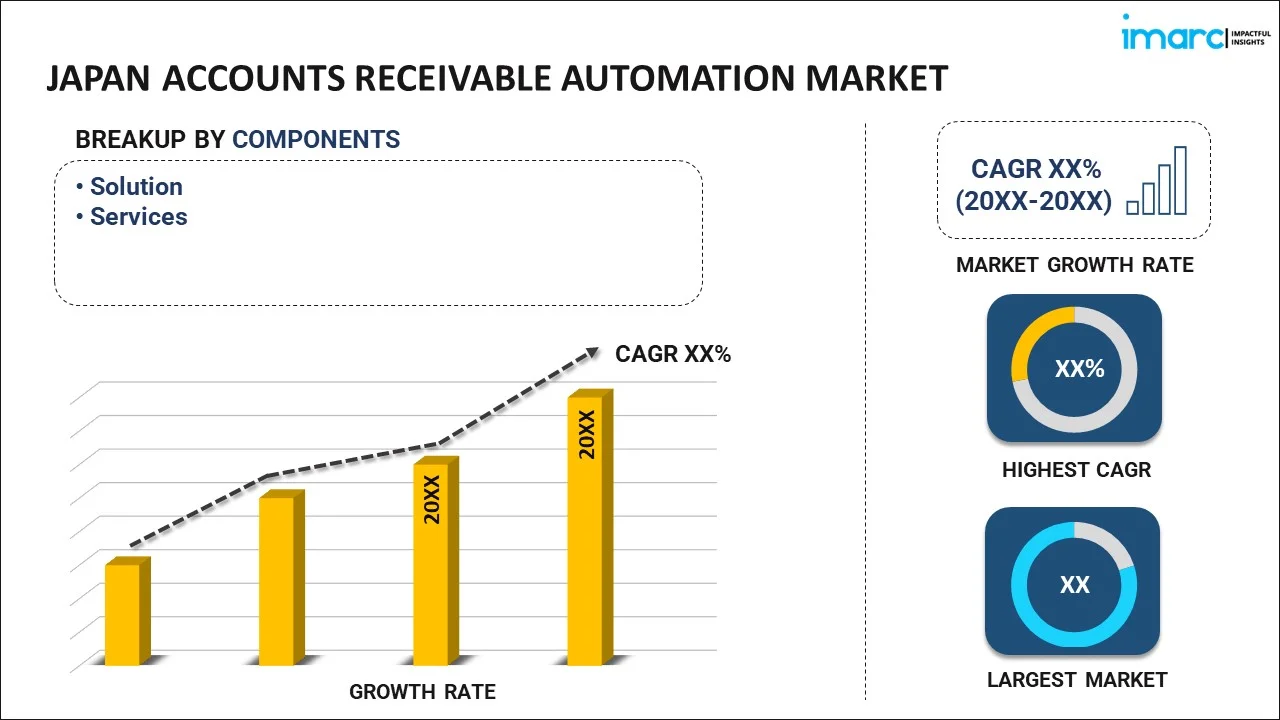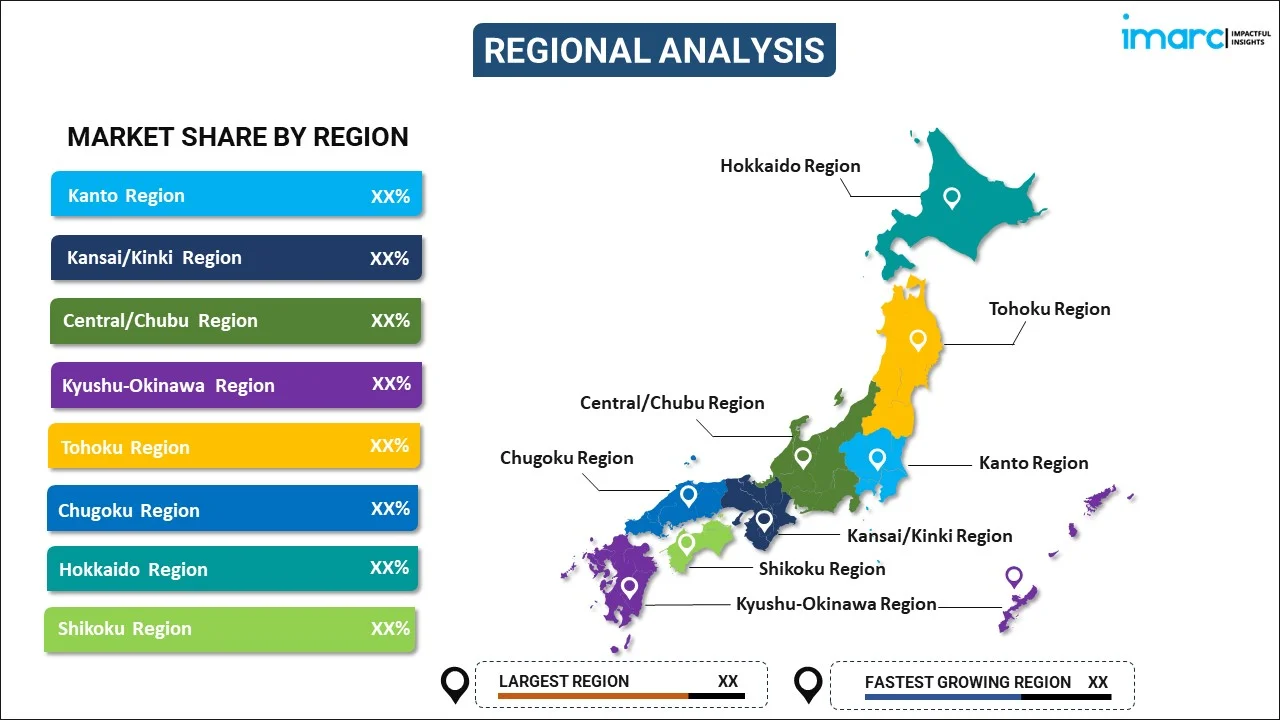
Japan Accounts Receivable Automation Market Report by Component (Solution, Services), Deployment (On-premises, Cloud-based), Organization Size (Large Enterprises, Small and Medium-sized Enterprises), Vertical (Consumer Goods and Retail, BFSI, Manufacturing, IT and Telecom, Healthcare, Energy and Utilities, and Others), and Region 2026-2034
Market Overview:
Japan accounts receivable automation market size reached USD 184.8 Million in 2025. Looking forward, IMARC Group expects the market to reach USD 462.6 Million by 2034, exhibiting a growth rate (CAGR) of 10.74% during 2026-2034. The rising need for automating and simplifying tasks, implementation of stringent data protection laws and compliance requirements, and the widespread adoption of ARA systems across different industry verticals represent some of the key factors driving the market.
|
Report Attribute
|
Key Statistics
|
|---|---|
|
Base Year
|
2025
|
|
Forecast Years
|
2026-2034
|
|
Historical Years
|
2020-2025
|
| Market Size in 2025 | USD 184.8 Million |
| Market Forecast in 2034 | USD 462.6 Million |
| Market Growth Rate 2026-2034 | 10.74% |
Access the full market insights report Request Sample
Accounts receivable automation (ARA) is a transformative financial process that leverages software and artificial intelligence (AI) to automate and simplify tasks associated with tracking, processing, and collecting accounts receivable. It can generate invoices automatically based on predefined billing cycles or customer orders. It accelerates the payment process and minimizes the risk of invoices loss in transit. It can securely process payments electronically and can be integrated with accounting software, such as QuickBooks or SAP, ensuring that all financial data is synchronized and up to date. It accelerates cash flow by expediting the payment cycle and reduces the days sales outstanding (DSO) and allows companies to invest in growth initiatives or pay down debt more efficiently. It assists businesses in meeting audit requirements and facilitates transparent financial reporting. Furthermore, as it provides a seamless invoicing and payment experience, the demand for ARA is rising in Japan.
Japan Accounts Receivable Automation Market Trends:
The increasing automation to achieve greater operational efficiency represents one of the primary factors influencing the market positively. ARA solutions offer a streamlined approach to invoice generation, delivery, payment processing, and reconciliation. Additionally, the rising reliance on ARA tools to gain better control over their receivables is offering a favorable market outlook. Apart from this, governing agencies of the country are focusing on promoting a paperless society, which is encouraging businesses to adopt electronic invoicing and payment methods. Furthermore, Japanese businesses are increasingly integrating ARA solutions with their enterprise resource planning (ERP) systems, which is strengthening the growth of the market. This integration allows for seamless data flow between financial operations and other critical business functions, enhancing overall efficiency and data accuracy. Moreover, the implementation of stringent data protection laws and compliance requirements is making ARA systems appealing. These solutions often come with robust security features, ensuring that sensitive financial data remains protected and compliant with local regulations. Besides this, leading businesses in Japan are increasingly leveraging data analytics for strategic decision-making. ARA solutions provide valuable insights through advanced reporting and analytics features, helping companies identify trends, customer behaviors, and areas for improvement. In addition, ARA providers in Japan are continually innovating and enhancing their solutions to meet evolving business needs. This innovation includes the incorporation of AI, machine learning (ML), and predictive analytics to improve accuracy and efficiency further. Along with this, the widespread adoption of ARA systems across different industry verticals, such as manufacturing, finance, healthcare, and retail, is strengthening the growth of the market.
Japan Accounts Receivable Automation Market Segmentation:
IMARC Group provides an analysis of the key trends in each segment of the market, along with forecasts at the country level for 2026-2034. Our report has categorized the market based on component, deployment, organization size, and vertical.
Component Insights:

To get detailed segment analysis of this market Request Sample
- Solution
- Services
The report has provided a detailed breakup and analysis of the market based on the component. This includes solution and services.
Deployment Insights:
- On-premises
- Cloud-based
A detailed breakup and analysis of the market based on the deployment have also been provided in the report. This includes on-premises and cloud-based.
Organization Size Insights:
- Large Enterprises
- Small and Medium-sized Enterprises
The report has provided a detailed breakup and analysis of the market based on the organization size. This includes large enterprises and small and medium-sized enterprises.
Vertical Insights:
- Consumer Goods and Retail
- BFSI
- Manufacturing
- IT and Telecom
- Healthcare
- Energy and Utilities
- Others
A detailed breakup and analysis of the market based on the vertical have also been provided in the report. This includes consumer goods and retail, BFSI, manufacturing, IT and telecom, healthcare, energy and utilities, and others.
Regional Insights:

To get detailed regional analysis of this market Request Sample
- Kanto Region
- Kansai/Kinki Region
- Central/ Chubu Region
- Kyushu-Okinawa Region
- Tohoku Region
- Chugoku Region
- Hokkaido Region
- Shikoku Region
The report has also provided a comprehensive analysis of all the major regional markets, which include Kanto Region, Kansai/Kinki Region, Central/ Chubu Region, Kyushu-Okinawa Region, Tohoku Region, Chugoku Region, Hokkaido Region, and Shikoku Region.
Competitive Landscape:
The market research report has also provided a comprehensive analysis of the competitive landscape. Competitive analysis such as market structure, key player positioning, top winning strategies, competitive dashboard, and company evaluation quadrant has been covered in the report. Also, detailed profiles of all major companies have been provided.
Japan Accounts Receivable Automation Market Report Coverage:
| Report Features | Details |
|---|---|
| Base Year of the Analysis | 2025 |
| Historical Period | 2020-2025 |
| Forecast Period | 2026-2034 |
| Units | Million USD |
| Scope of the Report | Exploration of Historical Trends and Market Outlook, Industry Catalysts and Challenges, Segment-Wise Historical and Future Market Assessment:
|
| Components Covered | Solution, Services |
| Deployment Types Covered | On-premises, Cloud-based |
| Organization Sizes Covered | Large Enterprises, Small and Medium-sized Enterprises |
| Verticals Covered | Consumer Goods and Retail, BFSI, Manufacturing, IT and Telecom, Healthcare, Energy and Utilities, Others |
| Regions Covered | Kanto Region, Kansai/Kinki Region, Central/ Chubu Region, Kyushu-Okinawa Region, Tohoku Region, Chugoku Region, Hokkaido Region, Shikoku Region |
| Customization Scope | 10% Free Customization |
| Post-Sale Analyst Support | 10-12 Weeks |
| Delivery Format | PDF and Excel through Email (We can also provide the editable version of the report in PPT/Word format on special request) |
Key Questions Answered in This Report:
- How has the Japan accounts receivable automation market performed so far and how will it perform in the coming years?
- What has been the impact of COVID-19 on the Japan accounts receivable automation market?
- What is the breakup of the Japan accounts receivable automation market on the basis of component?
- What is the breakup of the Japan accounts receivable automation market on the basis of deployment?
- What is the breakup of the Japan accounts receivable automation market on the basis of organization size?
- What is the breakup of the Japan accounts receivable automation market on the basis of vertical?
- What are the various stages in the value chain of the Japan accounts receivable automation market?
- What are the key driving factors and challenges in the Japan accounts receivable automation?
- What is the structure of the Japan accounts receivable automation market and who are the key players?
- What is the degree of competition in the Japan accounts receivable automation market?
Key Benefits for Stakeholders:
- IMARC’s industry report offers a comprehensive quantitative analysis of various market segments, historical and current market trends, market forecasts, and dynamics of the Japan accounts receivable automation market from 2020-2034.
- The research report provides the latest information on the market drivers, challenges, and opportunities in the Japan accounts receivable automation market.
- Porter's five forces analysis assist stakeholders in assessing the impact of new entrants, competitive rivalry, supplier power, buyer power, and the threat of substitution. It helps stakeholders to analyze the level of competition within the Japan accounts receivable automation industry and its attractiveness.
- Competitive landscape allows stakeholders to understand their competitive environment and provides an insight into the current positions of key players in the market.
Need more help?
- Speak to our experienced analysts for insights on the current market scenarios.
- Include additional segments and countries to customize the report as per your requirement.
- Gain an unparalleled competitive advantage in your domain by understanding how to utilize the report and positively impacting your operations and revenue.
- For further assistance, please connect with our analysts.
 Request Customization
Request Customization
 Speak to an Analyst
Speak to an Analyst
 Request Brochure
Request Brochure
 Inquire Before Buying
Inquire Before Buying




.webp)




.webp)












